Design Analysis of a Modified Current-Reuse Low-Power Wideband Single-Ended CMOS LNA
Abstract
1. Introduction
2. Analysis of the Proposed LNA
2.1. Input Impedance Matching
2.2. Voltage Gain
2.3. Noise Analysis
2.4. Linearity Analysis
3. Simulation Results
4. Conclusions
Author Contributions
Funding
Institutional Review Board Statement
Informed Consent Statement
Data Availability Statement
Conflicts of Interest
References
- Wan, Q.; Liu, J.; Chen, S. An Inductorless Gain-Controllable Wideband LNA Based on CCCIIs. Micromachines 2022, 13, 1832. [Google Scholar] [CrossRef] [PubMed]
- Razavi, B. RF Microelectronics; Prentice Hall: New York, NY, USA, 2012; Volume 2. [Google Scholar]
- Mir-Moghtadaei, S.V.; Bidabadi, F.S. A CMOS 3.5 GHz Bandwidth Low Noise Amplifier using Active Inductor. AUT J. Electr. Eng. 2025, in press. [Google Scholar]
- Hu, B.; Yu, X.P.; Lim, W.M.; Yeo, K.S. Analysis and Design of Ultra-Wideband Low-Noise Amplifier with Input/Output Bandwidth Optimization and Single-Ended/Differential-Input Reconfigurability. IEEE Trans. Ind. Electron. 2014, 61, 5672–5680. [Google Scholar]
- Farshad, S.B.; Mir-Moghtadaei, S.V. An Ultra-Wideband 0.1–6.1 GHz Low Noise Amplifier in 180 nm CMOS Technology. J. Circuits Syst. Comput. 2020, 30, 2150104. [Google Scholar]
- Cheng, K.-W.; Chen, W.-W.; Yang, S.-D. A Low Power Sub-GHz Wideband LNA Employing Current-Reuse and Device-Reuse Positive Shunt-Feedback Technique. IEEE Microw. Wirel. Compon. Lett. 2022, 32, 1455–1458. [Google Scholar] [CrossRef]
- Bruccoleri, F.; Klumperink, E.A.M.; Nauta, B. Wide-band CMOS low-noise amplifier exploiting thermal noise canceling. IEEE J. Solid-State Circuits 2004, 39, 275–282. [Google Scholar] [CrossRef]
- Shirmohammadi, B.; Yavari, M. A Linear Wideband CMOS Balun-LNA With Balanced Loads. IEEE Trans. Circuits Syst. II Express Briefs 2021, 69, 754–758. [Google Scholar] [CrossRef]
- Kim, S.; Kwon, K. A 50-MHz-1-GHz 2.3-dB NF noise- cancelling balun-LNA employing a modified current-bleeding technique and balanced loads. IEEE Trans. Circuits Syst. I 2019, 66, 546–554. [Google Scholar] [CrossRef]
- Kim, S.; Kwon, K. Broadband balun-LNA employing local feedback gm-boosting technique and balanced loads for low-power low-voltage applications. IEEE Trans. Circuits Syst. I 2020, 67, 4631–4640. [Google Scholar]
- Tiwari, S.; Mukherjee, J. An inductor less wideband Gm-boosted balun LNA with NMOS-PMOS configuration and capacitively coupled loads for sub-GHz IoT applications. IEEE Trans. Circuits Syst. II 2021. early access. [Google Scholar]
- Kishore, K.H.; Venkataramani, B.; Sanjay, R.; Rajan, V.S. High gain inductor less wideband Balun-LNA using asymmetric CCC & BIST using RMS detectors. AEU-Int. J. Electron. Commun. 2019, 105, 135–144. [Google Scholar]
- Mahmood, H.U.; Lee, S.-G.; Kim, J. A 0.1–4.2 GHz, 960-μW Inductor-Less and Negative Shunt Feedback LNA With Simultaneous Noise and Distortion Cancellation and Bandwidth Extension. IEEE Trans. Circuits Syst. I 2024, 71, 2563–2575. [Google Scholar] [CrossRef]
- Pu, Y.; Li, W.; Li, Q.; Ma, X.; Xu, H. A 0.2–3.2-GHz active Balun-LNA with 1.4–2.18-dB NF utilizing asymmetric current distribution in 28-nm CMOS. IEEE Microw. Wirel. Technol. Lett. 2025, 35, 326–329. [Google Scholar] [CrossRef]
- Liu, Z.; Boon, C.C.; Dong, Y. A 0.6 V, 1.74 mW, 2.9 dB NF Inductor less Wideband LNA in 28-nm CMOS Exploiting Noise Cancellation and Current Reuse. IEEE Trans. Circuits Syst. I 2024, 71, 3561–3572. [Google Scholar]
- Park, J.-W.; Kim, D.-Y.; Im, D. A Broadband Gm-Boosted Active Feedback CMOS Low-Noise Amplifier for Low- and Mid-Band 5G Applications. IEEE Trans. Circuits Syst. II Express Briefs 2025, 72, 399–403. [Google Scholar] [CrossRef]
- Hu, S.; Du, J.; Chen, P.; Nguyen, H.M.; Quinlan, P.; Siriburanon, T.; Staszewski, R.B. A Type-II Phase-Tracking receiver. IEEE J. Solid-State Circuits 2021, 56, 427–439. [Google Scholar] [CrossRef]
- Bahl, I.J. High-performance inductors. IEEE Trans. Microw. Theory Tech. 2001, 49, 654–664. [Google Scholar] [CrossRef]
- Hoen, T.J.; Jin, Y.; Annema, A.-J.; Wils, N.; Verlinden, J.; Nauta, B. Low TCL, High-Q Inductors in Standard CMOS. IEEE Microw. Wirel. Technol. Lett. 2024, 34, 179–182. [Google Scholar] [CrossRef]
- Sarpeshkar, R.; Delbruck, T.; Mead, C. White noise in MOS transistors and resistors. IEEE Circuits Devices Mag. 1993, 9, 23–29. [Google Scholar] [CrossRef]
- Filanovsky, I.M.; Allam, A. Mutual compensation of mobility and threshold voltage temperature effects with applications in CMOS circuits. IEEE Trans. Circuits Syst. I Fundam. Theory Appl. 2001, 48, 876–884. [Google Scholar] [CrossRef]




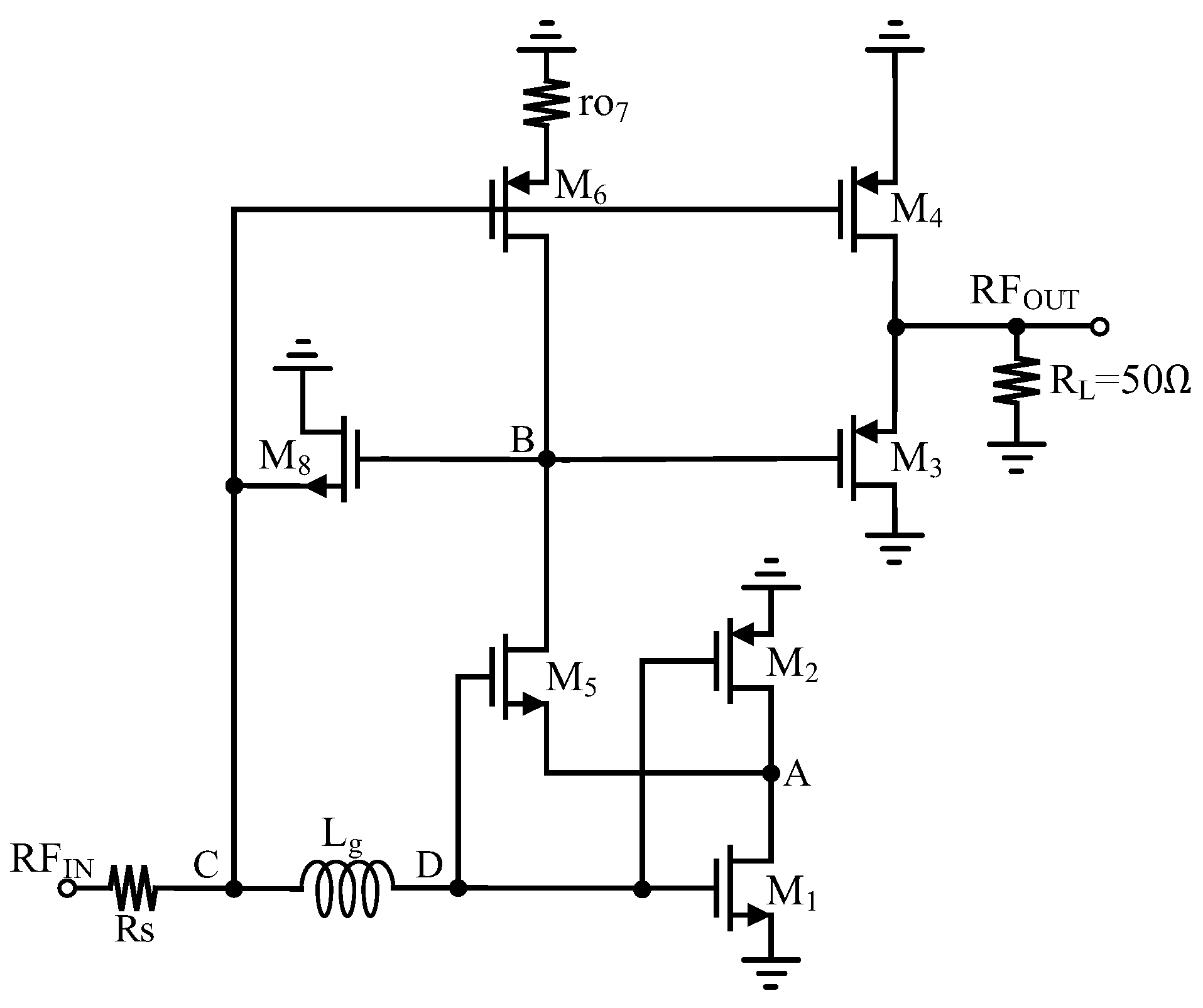
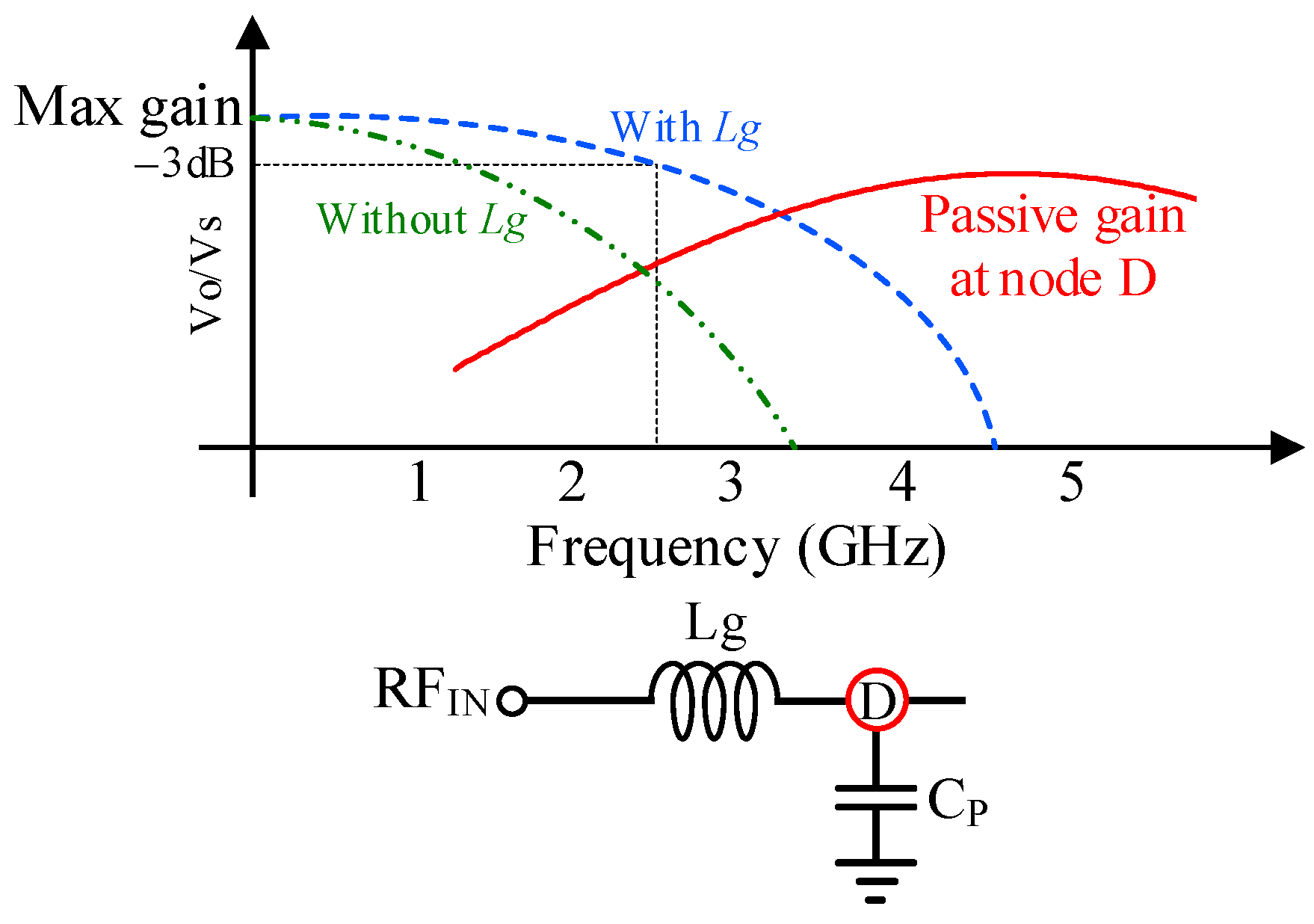


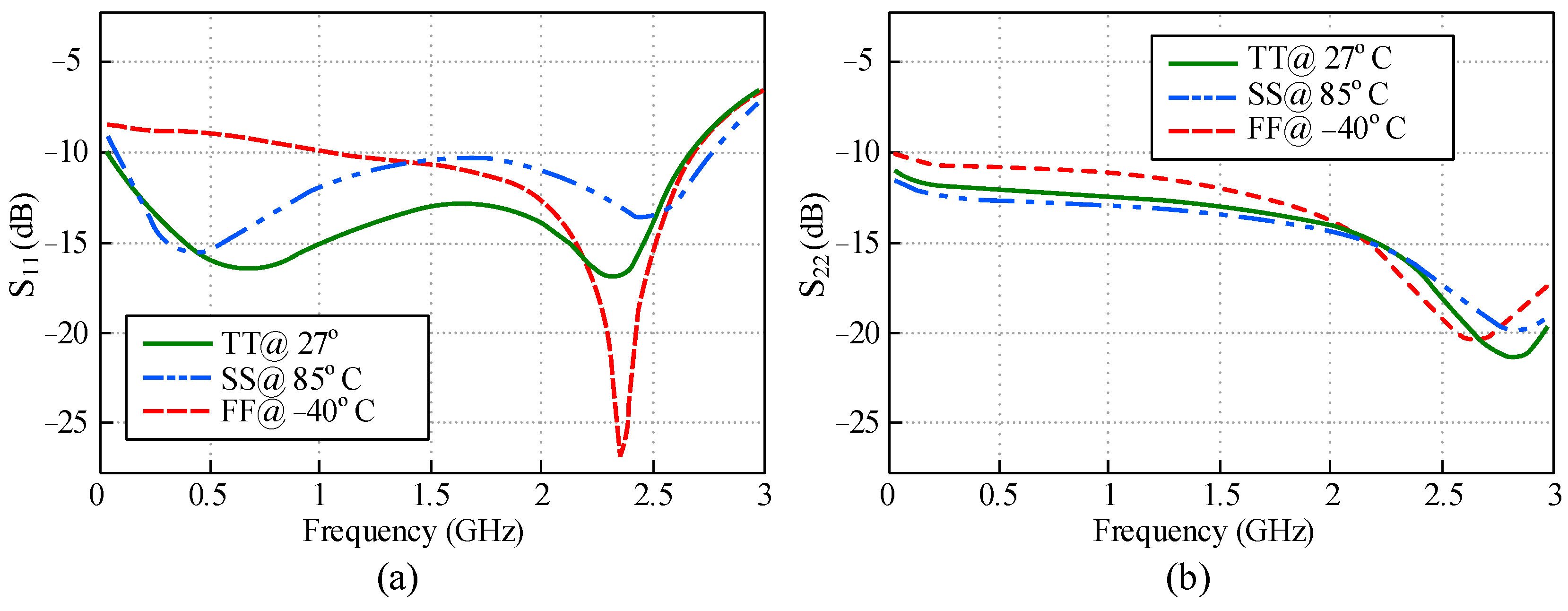
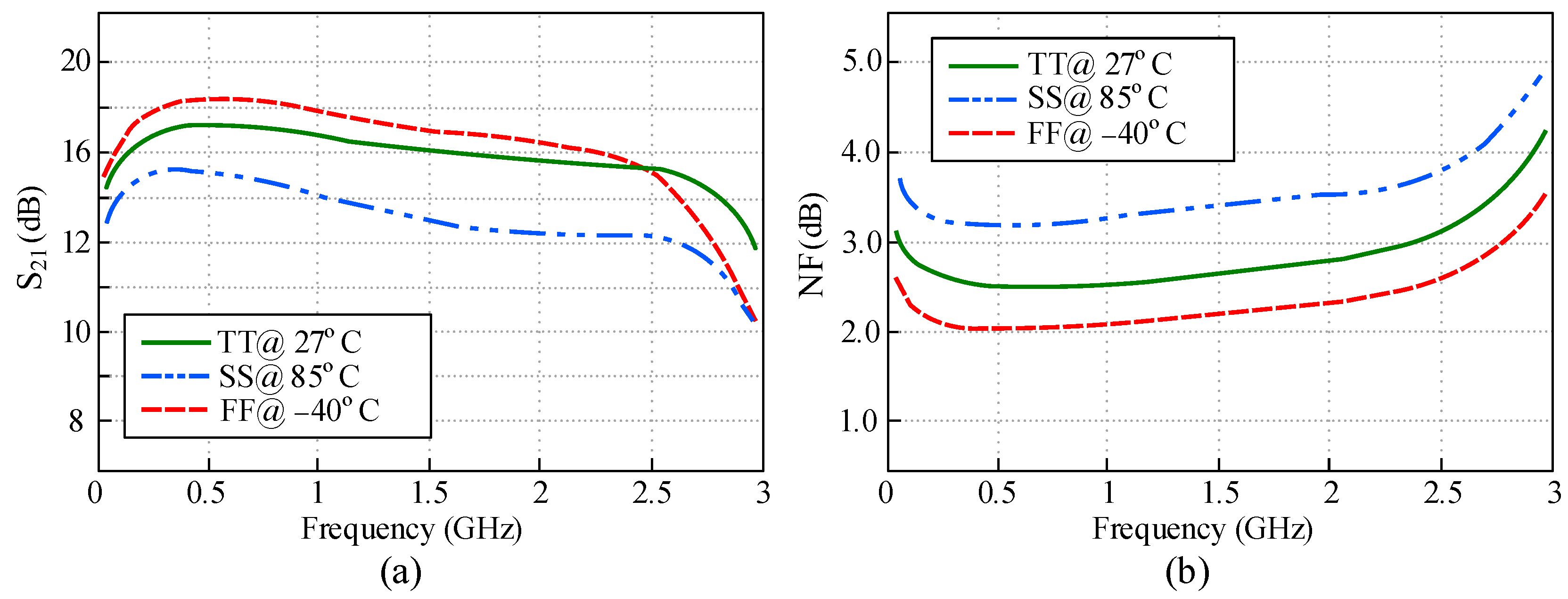
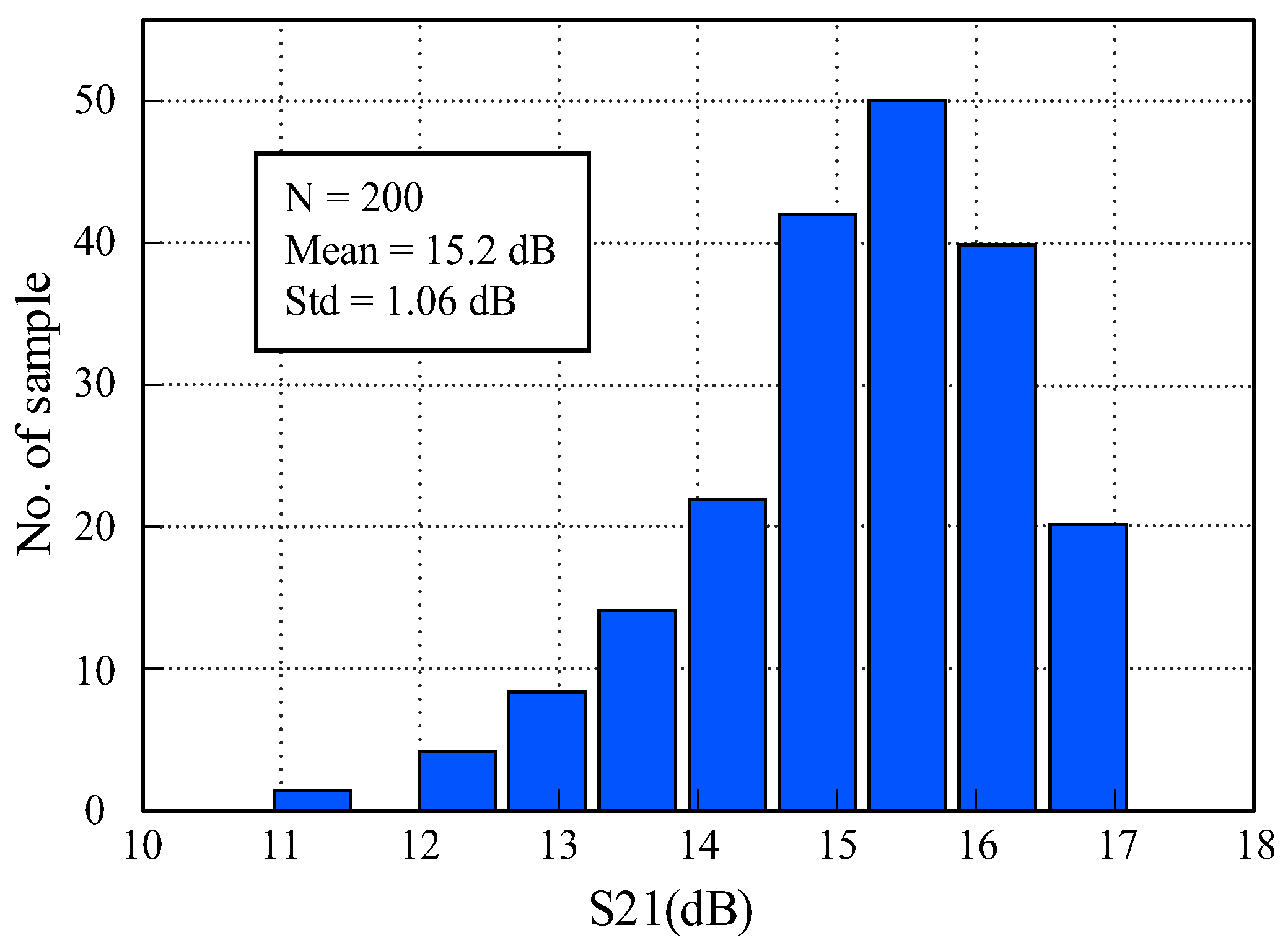
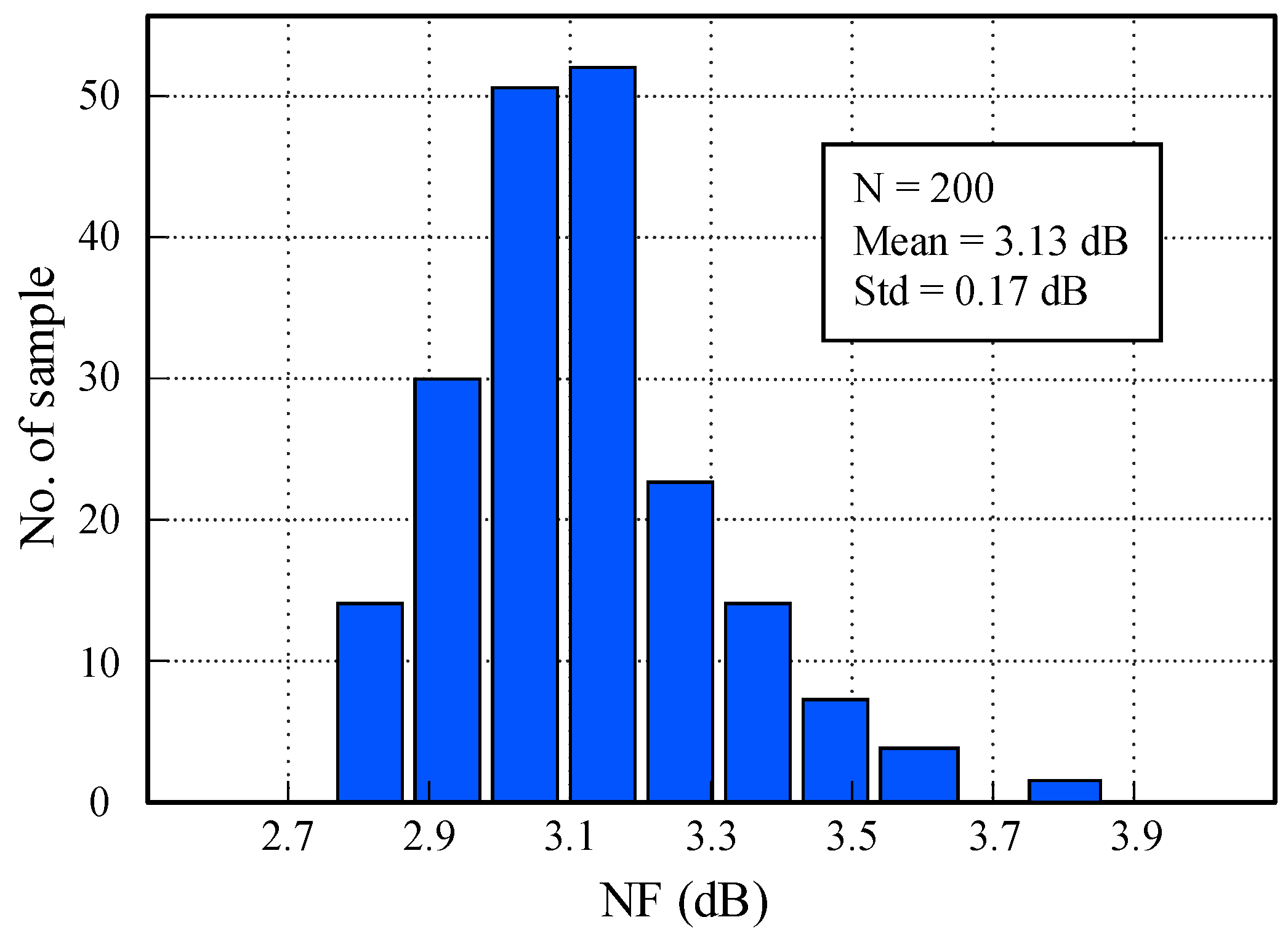
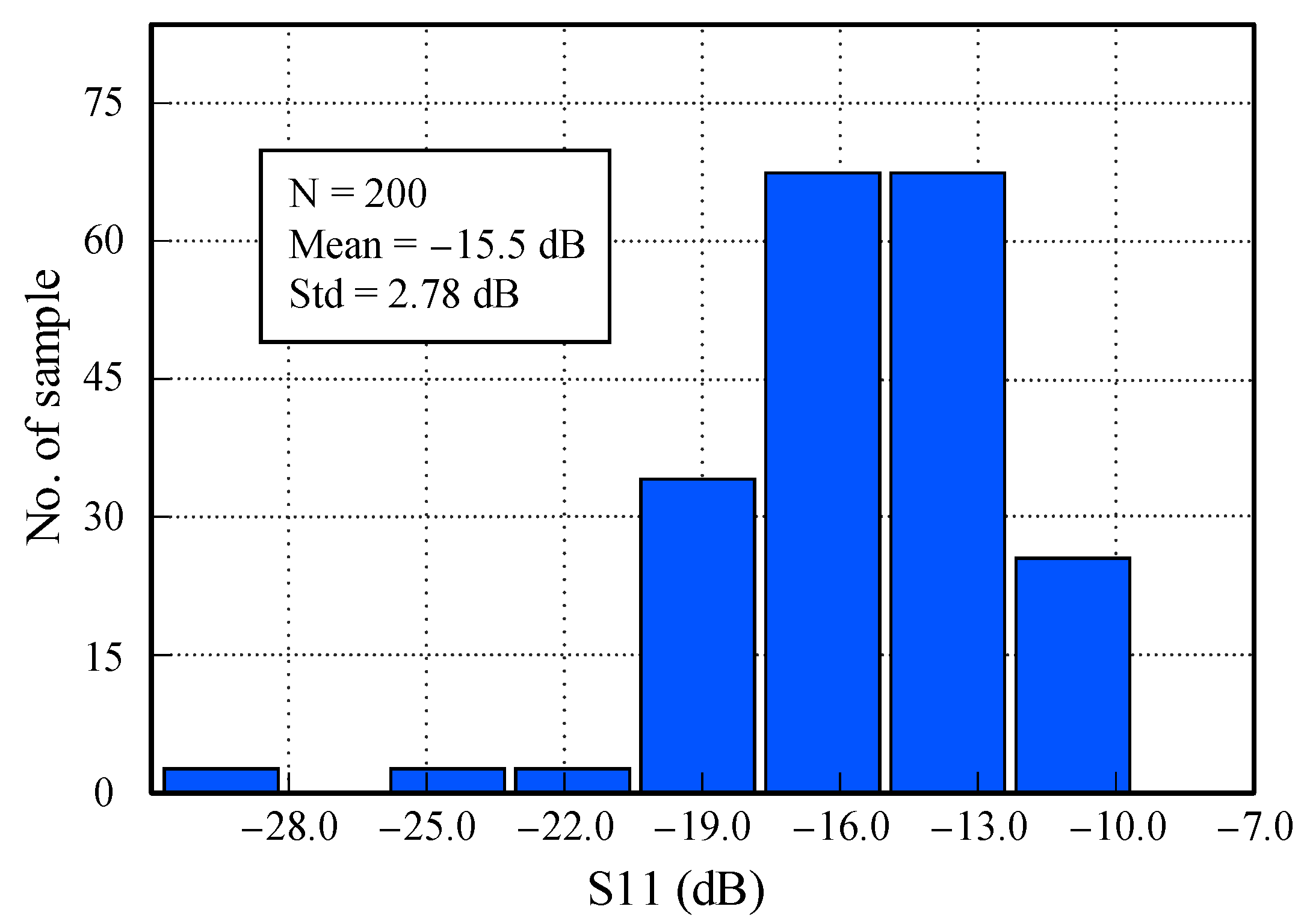
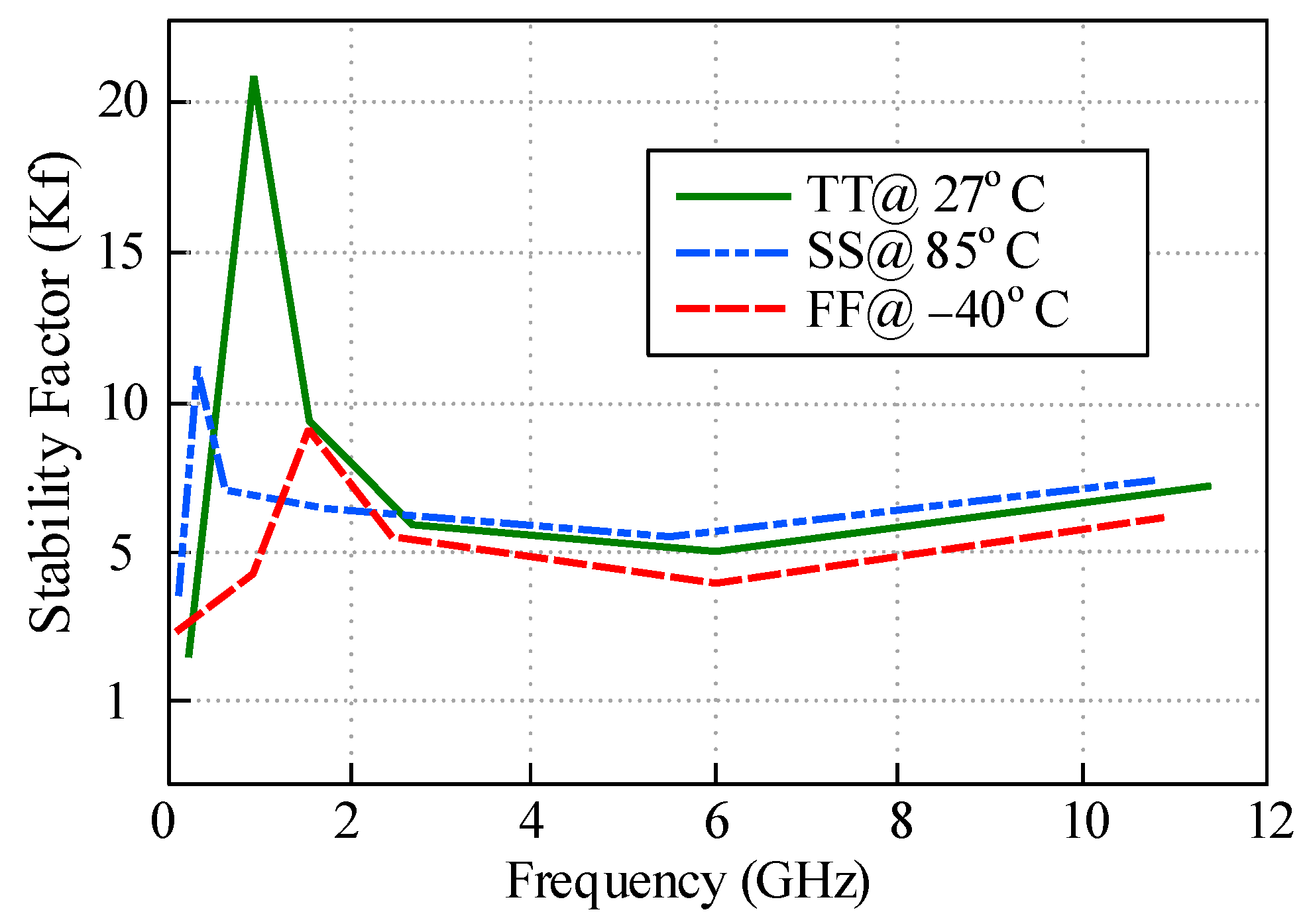
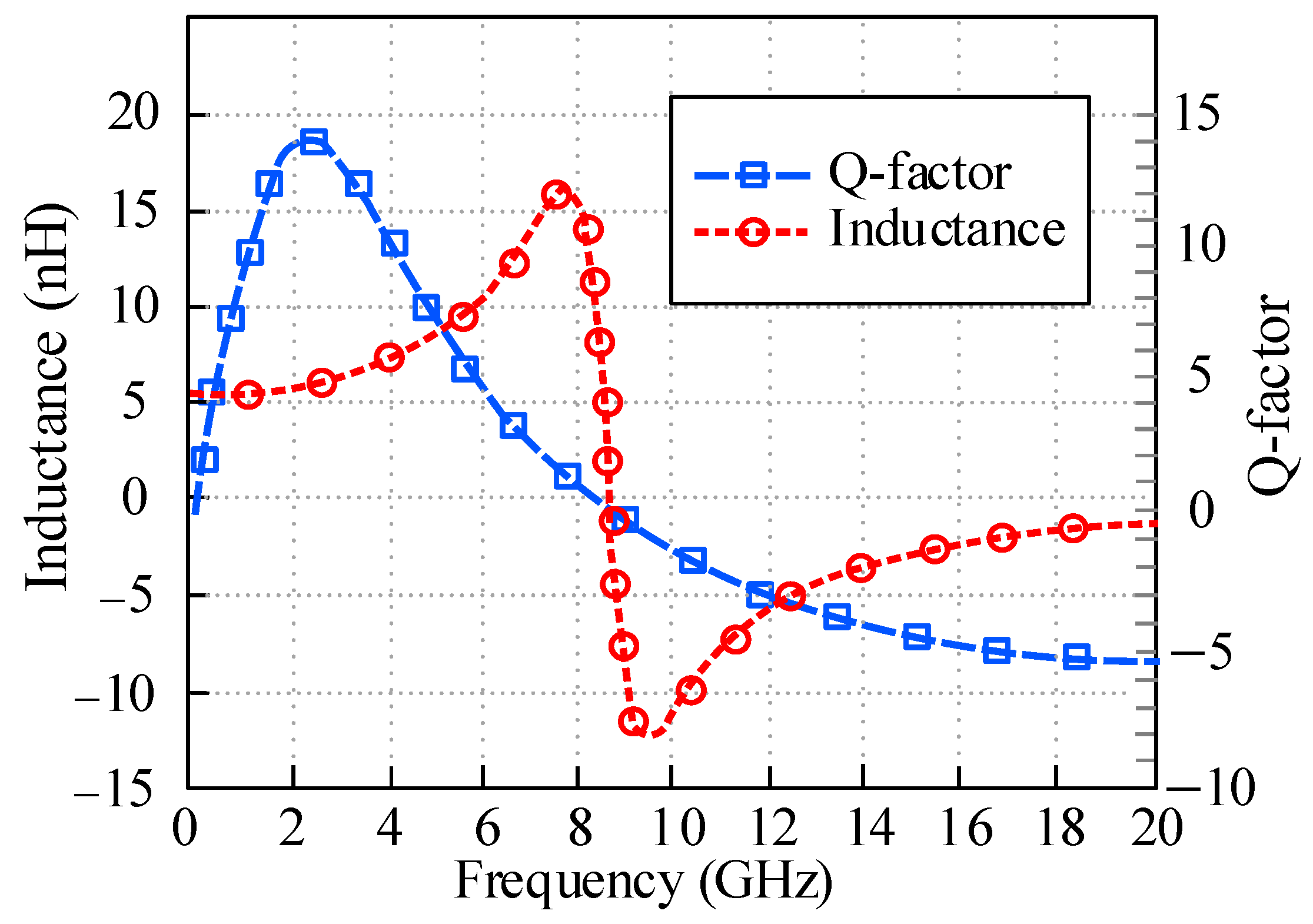
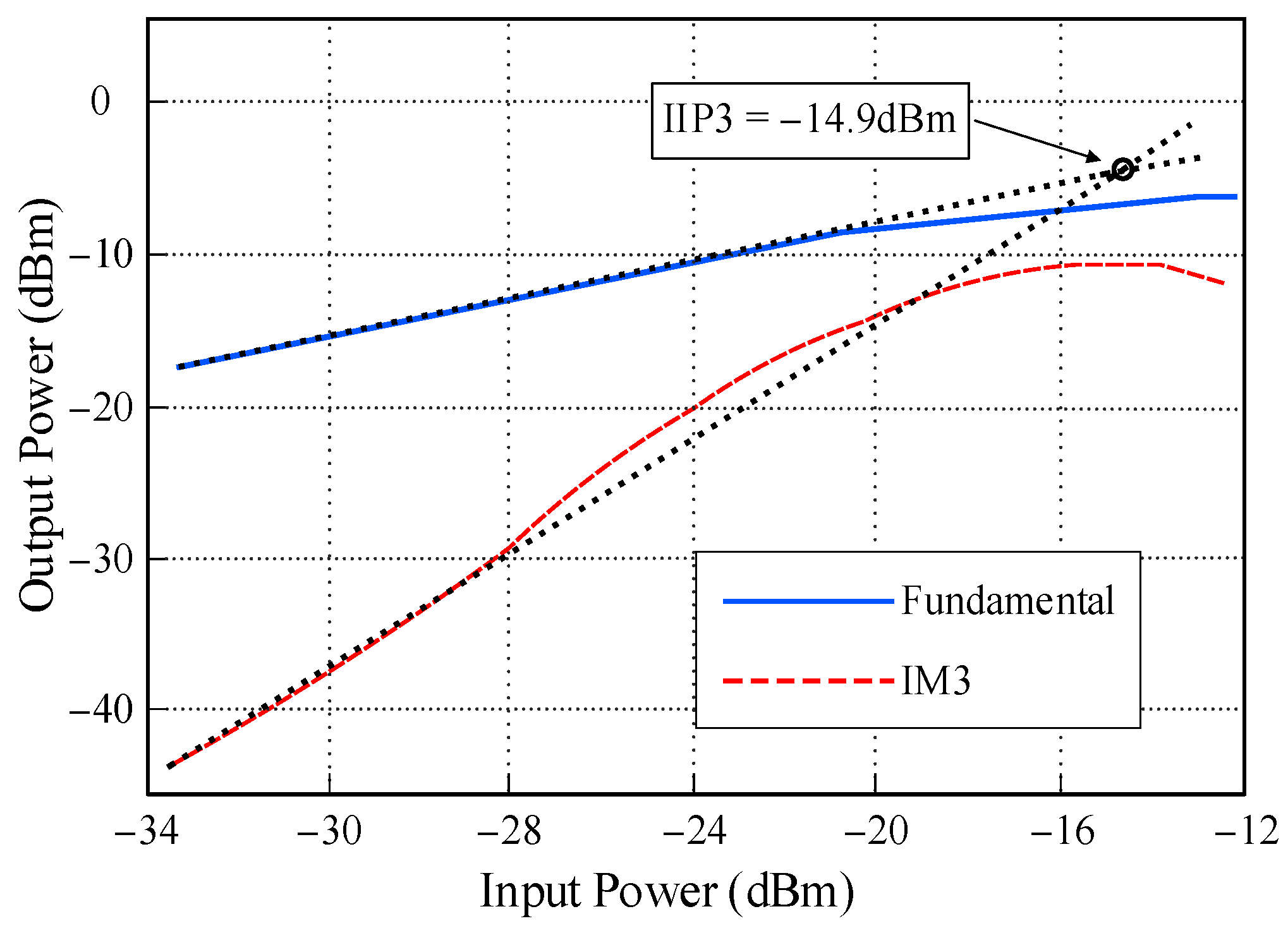



| Parameter | TT @ 27 °C | SS @ 85 °C | FF @ −40 °C |
|---|---|---|---|
| −3 dB BW (GHz) | 0.17–2.68 | 0.17–2.2 | 0.17–2.54 |
| S21 (dB) | 15–17.24 | 13.58–15.58 | 15.2–18.2 |
| NFmin (dB) | 2.67 | 3.35 | 1.99 |
| IIP3 (dBm) | −14.9 | −13 | −12.6 |
| Power (mW) | 3.52 | 3.64 | 2.87 |
| Reference | CMOS Process | VDD (V) | Frequency (GHz) | S21 (dB) | NF (dB) | S11 (dB) | IIP3 (dBm) | Symmetric Load | Power (mW) | Area (mm2) | FoM (dB) |
|---|---|---|---|---|---|---|---|---|---|---|---|
| TCAS-II′22 *,b [8] | 65 nm | 1.5 | 0.47–3.3 | 19.45–22 | 2.57–3.5 | <−10 | +2.81 | Yes | 12.5 | 0.057 | 11.02 |
| TCAS-I′19 b [9] | 65 nm | 2.2 | 0.05–1 | 24–30 | 2.3–3.3 | <−12 | −4.1 | Yes | 19.8 | 0.045 | 6.84 |
| TCAS-I′20 b [10] | 65 nm | 1 | 0.05–1.3 | 24–27.5 | 2.3–3 | <−12 | −2.2 | Yes | 5.7 | 0.046 | 17.73 |
| TCAS-II′21 b [11] | 180 nm | 1.8 | 0.13–0.93 | 16.6–19.6 | 3.6–5 | <−10 | −8.5 | Yes | 3 | 0.18 | 6.52 |
| AEUE′19 *,b [12] | 180 nm | 1.2 | 0.18–2 | 15–20.8 | 2.65–3.8 | <−8 | −4.91 | Yes | 4.9 | 0.04 | 13.7 |
| TCAS-I′24 b [13] | 65 nm | 0.78 | 0.1–4.2 | 15.6 | 4.45–6.9 | <−10 | −14.5 | No | 0.96 | 0.011 | 23.19 |
| MWT′25 [14] | 28 nm | 1.1 | 0.2–3.2 | 24.4–26 | 1.4–2.18 | <−15 | −3.6 | Yes | 17.4 | 0.018 | 19.13 |
| TCAS-I′24 b [15] | 28 nm | 0.6 | 0.2–2.85 | 20 | 2.9–3.6 | <−13 | −12.3 | No | 1.74 | 0.0048 | 24.19 |
| TCAS-II′25 b [16] | 130 nm | 1.3 | 0.01–1.7 | 21.5 | 1.1–1.9 | <−10 | −2.3 | Yes | 9.1 | 0.18 | 17.45 |
| This work * | 65 nm | 1 | 0.17–2.68 | 15–17.24 | 2.67–3.24 | <−10 | −14.9 | No | 3.52 | 0.3 | 15.7 |
Disclaimer/Publisher’s Note: The statements, opinions and data contained in all publications are solely those of the individual author(s) and contributor(s) and not of MDPI and/or the editor(s). MDPI and/or the editor(s) disclaim responsibility for any injury to people or property resulting from any ideas, methods, instructions or products referred to in the content. |
© 2025 by the authors. Licensee MDPI, Basel, Switzerland. This article is an open access article distributed under the terms and conditions of the Creative Commons Attribution (CC BY) license (https://creativecommons.org/licenses/by/4.0/).
Share and Cite
Shirani Bidabadi, F.; Nagarajan, M.; Bharatha Kumar, T.; Kiat Seng, Y. Design Analysis of a Modified Current-Reuse Low-Power Wideband Single-Ended CMOS LNA. Chips 2025, 4, 21. https://doi.org/10.3390/chips4020021
Shirani Bidabadi F, Nagarajan M, Bharatha Kumar T, Kiat Seng Y. Design Analysis of a Modified Current-Reuse Low-Power Wideband Single-Ended CMOS LNA. Chips. 2025; 4(2):21. https://doi.org/10.3390/chips4020021
Chicago/Turabian StyleShirani Bidabadi, Farshad, Mahalingam Nagarajan, Thangarasu Bharatha Kumar, and Yeo Kiat Seng. 2025. "Design Analysis of a Modified Current-Reuse Low-Power Wideband Single-Ended CMOS LNA" Chips 4, no. 2: 21. https://doi.org/10.3390/chips4020021
APA StyleShirani Bidabadi, F., Nagarajan, M., Bharatha Kumar, T., & Kiat Seng, Y. (2025). Design Analysis of a Modified Current-Reuse Low-Power Wideband Single-Ended CMOS LNA. Chips, 4(2), 21. https://doi.org/10.3390/chips4020021








